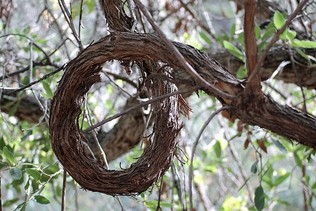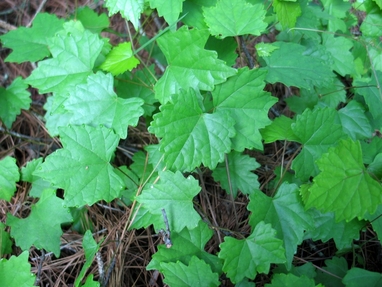Vitis (grapevines) is a genus of about 60 species of vining plants in the
flowering plant family Vitaceae. Grape vines grow thicker and higher than most
other native vines. All are perennial, woody vines that are deciduous. Commonly
found growing up into the forest canopy, this high-climbing, multi-stemmed vine
can envelop bushes and trees.
Distinguishing Features:
Wild grapevines thrive in hot and humid conditions, and typically grow by roadsides, fence rows, forest edges along river banks, and hardwood forests. Wild grapevine leaves are heart-shaped, glossy and grow to 4 inches wide, with a smooth texture and serrated edges.
The wild grape vine climbs very well due to its tendrils, or narrow branches, that grasp by coiling themselves around anything they can. Grape tendrils most often are found growing from a stalk opposite from a leaf.
Distinguishing Features:
Wild grapevines thrive in hot and humid conditions, and typically grow by roadsides, fence rows, forest edges along river banks, and hardwood forests. Wild grapevine leaves are heart-shaped, glossy and grow to 4 inches wide, with a smooth texture and serrated edges.
The wild grape vine climbs very well due to its tendrils, or narrow branches, that grasp by coiling themselves around anything they can. Grape tendrils most often are found growing from a stalk opposite from a leaf.
Flowers & Leaves:
Wild grapevine leaves are heart-shaped, glossy and grow to 4 inches wide, with a smooth texture and serrated edges.
Tiny white flowers in elongated clusters grow up to 10 cm in length. They bloom in early summer, after which tiny clusters of hard, green grapes develop. In late summer these grapes ripen. Wild grape vine flowers are hermaphrodite and are insect pollinated.
Edible parts:
The ripe grape can be eaten but tastes better after the first frost. They are not that large so eating them as a trail snack is suggested. The leaves are also edible. The leaves have a tangy citrusy taste, and can be eaten in a salad or cooked.
.
Location |
|

